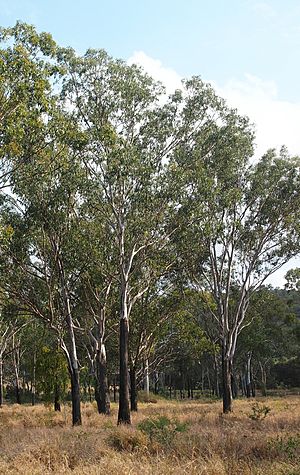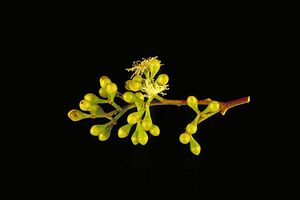Dawson River blackbutt facts for kids
Quick facts for kids Dawson River blackbutt |
|
|---|---|
 |
|
| Scientific classification | |
| Genus: |
Eucalyptus
|
| Species: |
cambageana
|
Eucalyptus cambageana, also known as the Dawson River blackbutt, Dawson gum, or Coowarra box, is a special type of tree. It is found only in Queensland, Australia. This medium-sized tree has rough, dark bark at the bottom of its trunk. Higher up, its bark is smooth and white or cream-colored. It has long, curved leaves, white flowers, and fruit shaped like a cup.
Contents
What Does It Look Like?
The Dawson River blackbutt is a tree that usually grows up to 25 meters (about 82 feet) tall. It has a special woody swelling at its base called a lignotuber. This helps the tree regrow if it gets damaged, for example, by fire.
The bark on the lowest 2 to 3 meters (about 6.5 to 10 feet) of the trunk is hard, rough, and dark grey to black. Above this, the bark suddenly changes to smooth, white, or light grey.
Young plants and new shoots (called coppice regrowth) have egg-shaped leaves. These leaves are about 70 to 145 mm (2.8 to 5.7 inches) long and 30 to 63 mm (1.2 to 2.5 inches) wide. They have a dull bluish-grey color.
Adult leaves are shaped like a spear (lance-shaped) and sometimes curved. They are glossy green on both sides. These leaves are about 75 to 165 mm (3 to 6.5 inches) long and 12 to 30 mm (0.5 to 1.2 inches) wide. Each leaf is attached to a stem called a petiole, which is about 10 to 27 mm (0.4 to 1.1 inches) long.
The tree's flower buds grow in groups of seven. They are found where the leaves meet the stem (called leaf axils). Each group of buds is on a small stalk called a peduncle, about 5 to 12 mm (0.2 to 0.5 inches) long. Each individual flower bud is on an even smaller stalk called a pedicel, usually 3 to 6 mm (0.1 to 0.2 inches) long.
Mature buds are oval-shaped, about 4 to 5 mm (0.16 to 0.20 inches) long and 2 to 4 mm (0.08 to 0.16 inches) wide. They have a cap-like cover called an operculum that can be cone-shaped or rounded.
The Dawson River blackbutt flowers between July and September, and its flowers are white. After flowering, the fruit develops. It is a woody, cup-shaped or funnel-shaped capsule. This capsule is about 3 to 6 mm (0.1 to 0.2 inches) long and 5 to 6 mm (0.2 to 0.24 inches) wide. The parts that open to release seeds (called valves) are tucked inside the rim of the fruit.
How It Got Its Name
The Eucalyptus cambageana was first officially described in 1913 by a botanist named Joseph Maiden. He described it from a sample collected in 1912 near Charters Towers. The second part of its scientific name, cambageana, was chosen to honor another surveyor and botanist, Richard Hind Cambage.
Where It Lives
The Dawson River blackbutt is found in Queensland, Australia. You can see it from places like Charleville, Charters Towers, and Jericho all the way to the coast.
It grows in areas with scrubland or open woodland. It often grows alongside other trees like brigalow (Acacia harpophylla), belah (Casuarina cristata), and wilga (Geijera parviflora). These woodlands where it grows are usually found on clay, alluvial (river-deposited), or sedimentary soils. This tree often grows in special types of soil called 'sodic soil'.
Is It Protected?
The Queensland Government lists this eucalypt as "least concern" under its Nature Conservation Act 1992. This means it is not currently considered to be at high risk of disappearing.
What Is It Used For?
The wood of the Dawson River blackbutt is heavy and reddish-brown. Local people often use it for fence posts. While it grows too large for most home gardens, its unique contrasting bark makes it a good choice for parks and larger properties.
See also
 In Spanish: Eucalyptus cambageana para niños
In Spanish: Eucalyptus cambageana para niños


